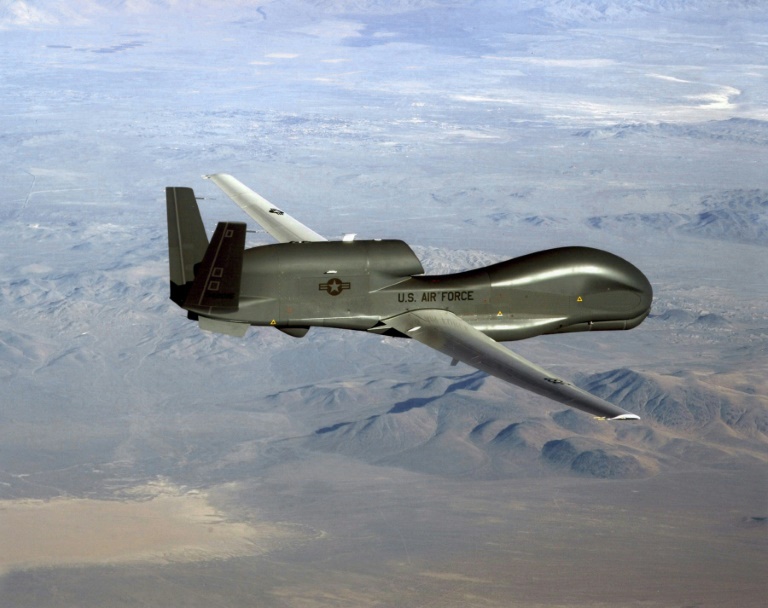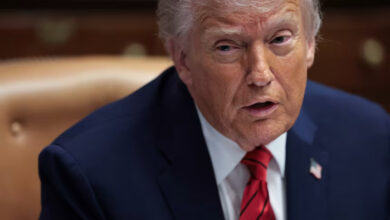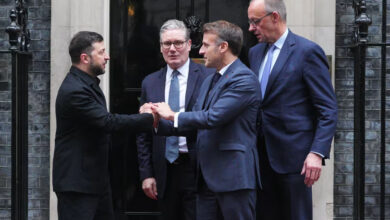
Iran said Friday it had “indisputable” evidence a US drone it downed had violated its airspace, as reports emerged in the US that President Donald Trump had approved then scrapped retaliatory strikes against Iranian targets.
The downing of the drone — which Washington insists was above international waters but Iran says was within its airspace — has seen tensions between the two countries spike further after a series of attacks on tankers the US has blamed on Tehran.
Under pressure to respond to the high-stakes incident near the strategic Strait of Hormuz, Trump issued orders for retaliatory strikes on a limited number of Iranian targets, the New York Times reported.
The US was planning to hit “a handful of Iranian targets, like radar and missile batteries” Thursday evening, the newspaper said, citing senior administration officials, but the plan was suddenly aborted in its early stages.
White House and Pentagon officials declined to comment, the Times said, and it was unclear whether Trump had decided to delay retaliatory strikes or cancel them altogether.
The US president had struck a combative tone in his public comments before rowing back.
“Iran made a very big mistake!” he tweeted in response to news Iran had shot down the Global Hawk surveillance aircraft.
“This country will not stand for it, that I can tell you,” he said later at the White House.
But as the pre-dawn incident whipped up fears of open conflict between the United States and its declared foe Iran — sending crude oil prices soaring — Trump moved swiftly to dial back tensions.
“I find it hard to believe it was intentional, if you want to know the truth,” Trump said. “I think that it could have been somebody who was loose and stupid that did it.”
 AFP / MANDEL NGANUS President Donald Trump said Iran had “made a very big mistake” following the downing of a US drone near the strategic Strait of Hormuz
AFP / MANDEL NGANUS President Donald Trump said Iran had “made a very big mistake” following the downing of a US drone near the strategic Strait of HormuzThe president’s mixed message left the world unsure what Washington’s next move would be.
Iran said Friday it had called in the Swiss ambassador, whose country has represented US interests since the severance of diplomatic relations in the aftermath of the Islamic revolution of 1979, to issue a formal protest.
Deputy foreign minister Abbas Araghchi provided the ambassador with “indisputable” evidence the drone had violated Iranian airspace, the foreign ministry said.
“Even some parts of the drone’s wreckage have been retrieved from Iran”s territorial waters,” Araghchi told the Swiss envoy.
Araghchi “reiterated that Iran does not seek a war and conflict in the Persian Gulf”, but warned: “The Islamic Republic of Iran would not hesitate for a moment to decisively defend its territory against any aggression.”
Foreign Minister Mohammad Javad Zarif said Thursday that Iran would go to the United Nations to prove that the drone had entered its airspace before being shot down.
“We don’t seek war, but will zealously defend our skies, land & waters,” Zarif tweeted.
US flight restrictions
The US Federal Aviation Administration warned of danger to flights “demonstrated by the Iranian surface-to-air missile shoot-down of a US unmanned aircraft system,” and barred American civilian aircraft from the area where it took place “until further notice.”
The Pentagon denounced the “unprovoked attack,” claiming the navy drone was 34 kilometres (21 miles) from Iran when destroyed by a surface-to-air missile.
It published a map showing the flight path of the drone, which indicated it travelled outside of Iranian waters and included a photograph showing it was at the coordinates (25°57’42″N 56°50’22″E) when it was downed.
Zarif provided different coordinates.
 AFP/File / Brendan Smialowski Trump’s arrival in the White House, alongside veteran Mideast hawks like national security adviser John Bolton, has seen sharp deterioration in relations with Tehran
AFP/File / Brendan Smialowski Trump’s arrival in the White House, alongside veteran Mideast hawks like national security adviser John Bolton, has seen sharp deterioration in relations with Tehran“At 00:14 US drone took off from UAE in stealth mode & violated Iranian airspace,” Zarif tweeted. “It was targeted at 04:05 at the coordinates (25°59’43″N 57°02’25″E) near Kouh-e Mobarak.
In a letter to the UN Security Council and UN Secretary General Antonio Guterres, Iran protested against a “dangerous and provocative act by the US military forces against the territorial integrity of the Islamic Republic of Iran.”
The drone downing came as Iran was already accused by Washington of carrying out attacks on tankers in the congested shipping lanes heading out of the Gulf through the Strait of Hormuz.
Tehran denies any involvement.
The commander of the US Naval Forces Central Command, Sean Kido, said a mine allegedly used in one of the attacks matched Iranian weaponry and that incriminating fingerprints had also been collected.
Options ‘running out?’
Trump has repeatedly said he does not favor war with Iran unless it is to stop the country getting a nuclear weapon — something Iranian leaders insist they are not pursuing.
But Trump critics say his policy of “maximum pressure” — including crippling economic sanctions, abandonment of an international deal to regulate Iran’s nuclear activities, and deployment of extra troops to the region — make war ever more likely.
 AFP / Paz PIZARROMap of Iran locating Hormozgan province, where the Revolutionary Guard said it shot down a US drone. The Pentagon say it was downed in international airspace
AFP / Paz PIZARROMap of Iran locating Hormozgan province, where the Revolutionary Guard said it shot down a US drone. The Pentagon say it was downed in international airspaceA key Republican ally of Trump, Senator Lindsey Graham, said the president’s “options are running out”.
Asked if he believed the countries were nearing conflict, he replied: “I think anybody would believe that we’re one step closer.”
One of Trump’s biggest opponents, the Democratic speaker of the House of Representatives, Nancy Pelosi, warned that “there’s no appetite for wanting to go to war in our country”.
Russian President Vladimir Putin, who has close relations with Iran’s leadership, said US military retaliation “would be a disaster for the region.”




